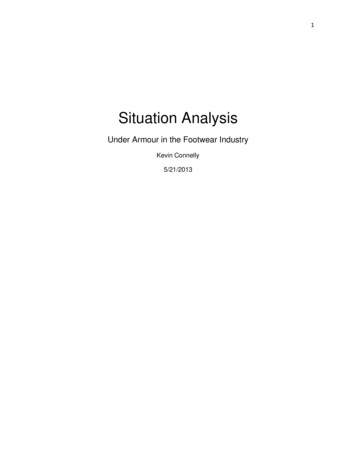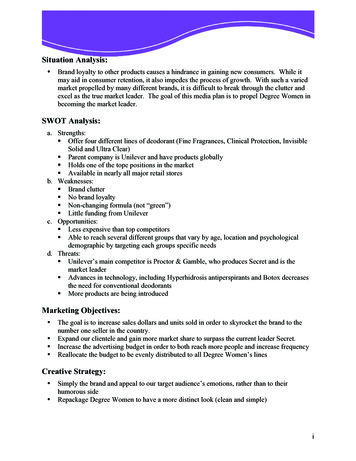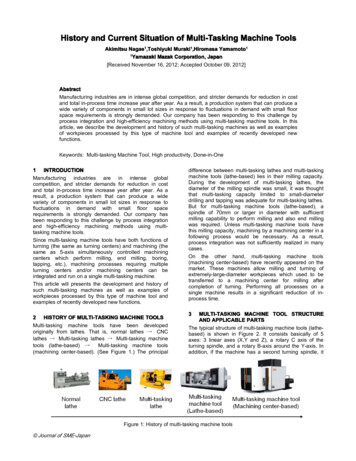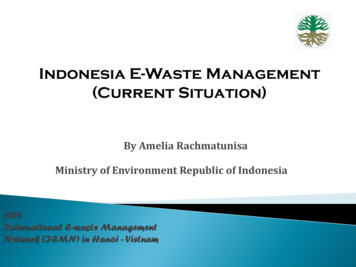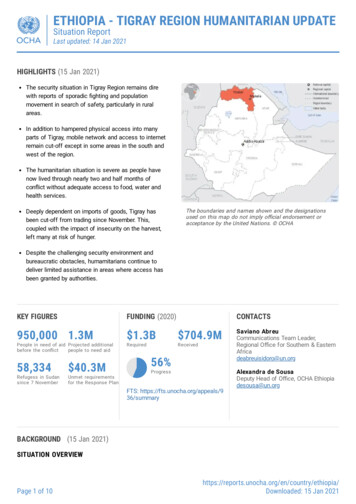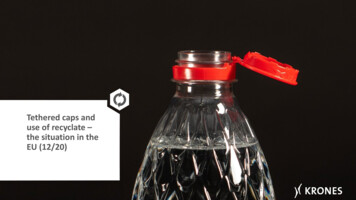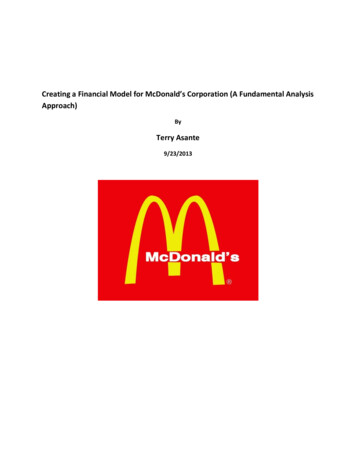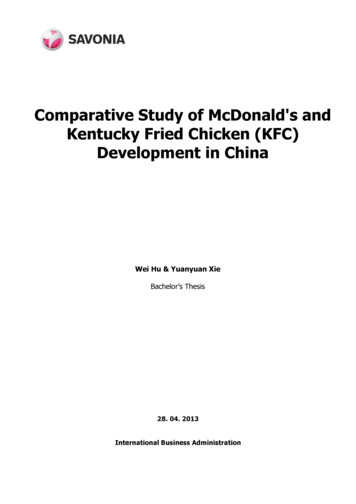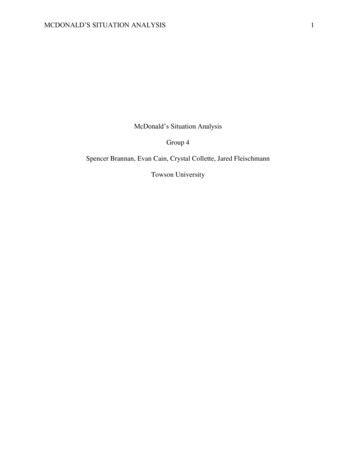
Transcription
MCDONALD’S SITUATION ANALYSIS1McDonald’s Situation AnalysisGroup 4Spencer Brannan, Evan Cain, Crystal Collette, Jared FleischmannTowson University
MCDONALD’S SITUATION ANALYSIS2Situation AnalysisGroup 4 was tasked with examining the issue of negative brand perception by consumers and theeffects it has on McDonald’s. Negative attention from the public has become a growing issue notjust within the company, but the fast-food industry as a whole. McDonald’s has been able tocounter the negative publicity due to the vast amount of store locations within the U.S. and theconsistent push to be a global leader in the industry. McDonald’s sales have increased in all areasof the world, especially in Europe, where sales have increased 5.6% since February (Struck,2011). Nonetheless, McDonald’s has reached at the new trend of a healthy lifestyle byincorporating a substitute salad or apple slices when preferred, but this strategy hasn’t lived up tothe expectations that McDonald’s had of being viewed as a healthy food chain. Competitors havealso moved away from the cheap meal ingredients to drive down the cost and have evolved to fitwith customer preferences. Negative customer perception of this company won’t hurt profits inthe short-run, but the long-term effects and unknown.Group 4 recommends that McDonald’s take the following actions to change the negative brandperception:1. Focus on changing the perceived quality of food2. Ensure the best customer experience3. Continue promotions that improve brand image.
MCDONALD’S SITUATION ANALYSIS3Company and Industry AnalysisMcDonald's Corporation is in 119 countries around the world. 33,000 locations serve over 68million customers each day (Data Monitor, 2011). When it comes down to the McDonald’s as abrand and fast food industry, the sales are high, but the brand perception is not keeping up withthe pace. Rated the world’s number 6 brand by Interbrand, McDonald’s brand is negativelyperceived by the public (Morrison, 2011). A few factors that influence the negative effect onMcDonalds brand perception include the issue of obesity, the involvement of animal cruelty,social media commentary, and targeting an innocent audience with manipulation.The Growing Negative Image That Obesity is CreatingReading headlines in the most reputable newspapers saying, “McDonald’s is the responsible forthe obesity epidemic”, is harsh (Phillips, 2006). Just reading that headline can quickly alter aperson’s perception about the brand. Obesity side effects may include self-esteem issues,depression and anxiety. In this generation, popular culture continues to hold thinness as thephysical ideal. When looking at McDonald’s brand perception, they are extremely affected byobesity criticism as a result of their unhealthy foods. People are viewing McDonald’s as arestaurant that can easily be the cause of obesity, which is detrimental to its brand. The constantcriticism began in 2003 and the following year in 2004, McDonald’s suffered its first major lossin profit due to the impact of how badly their image was affected (Goldie, 2006).There have been a number of observational studies that show the association between frequentfast food intake and weight gain (Stender, Dyerberg, & Astrup, 2007). The fast food industryoffers more convenience and more availability. For example, without access to supermarket
MCDONALD’S SITUATION ANALYSIS4fresh products at relatively late hours, you’re more prone to choose an unhealthier alterative dueto the availability (Joyce, 2011). Along with the large portion sizes, fast food is alsocharacterized by high-energy density, which is high energy content/food-weight ratio (Stender,Dyerberg, & Astrup, 2007). Thus, the fast food industry influences terrible eating habits, whichis how it is associated with obesity.Negative Reactions to “Pink Slime”In relation to the accusations that McDonalds being responsible for the obesity growth, “pinkslime” has been a critical issue as well when it comes to negative effects on McDonald’s brandperception. What exactly is “pink slime”? Pink Slime is technically called ‘boneless lean beeftrimmings’ (Stender, Dyerberg, & Astrup, 2007). This product has been used in burgers by fastfood restaurants as well as in hotdogs. Earlier this year, an episode of Jamie Oliver’s FoodRevolution brought to the attention of what “pink slime” was and what chains are using it. Afterexplaining that the trimming consists of what’s left of the meat after all the choice cuts of beefare taken, consumers did not respond positively. In the U.K, “pink slime” is instead used for dogand chicken food. The uproar of “pink slime” was indeed a result of McDonald’s taking a hit.The “pink slime” cause consumers to think twice about what they were actually consumer on adaily basis. “Was this healthy?” “Was this legal?” The most important factor in brandperception is the company’s product quality. The “pink slime” turmoil definitely caused a lot ofnegative feedback on McDonald’s brand perception.Much of the public are unaware of what happens to their food before it arrives on their plate.When consumers find out everything the fast food industries don’t want them to know, it
MCDONALD’S SITUATION ANALYSIS5becomes an uproar. Although the brand portrays a clean and bright image, the food quality isdisplaying something completely different, thus having a negative view to the public. The morepeople continue to complain about processed foods within the fast food industries, the morenegative the outcome will be which is affecting the perception in the end.Animal CrueltyNext, animal cruelty is a huge factor in how McDonald’s brand is negatively perceived.Recently, McDonalds Corporation cut ties with Central Valley Meat Company (Hsu, 2012).This sudden decision was made due to the result of undercover footage from an animal welfaregroup. This particular video showed cows at the California slaughterhouse being tortured andmistreated. Although McDonald’s no longer gets their meat from Central Valley, the branddefinitely took some hard criticism. The larger focus became McDonald’s association withanimal cruelty. The gruesome images and videos of mistreatment made it even worse for thebrand perception. Whether McDonald’s had known about the mistreatment of these animals ornot, their brand was still tainted.Several articles, including gruesome images, display what fast food industries are associated within relation to animal abuse. Consumers are not only mortified, but will no long want to supportthe fast food industry if they see that they are associated with or condoning the slaughtering ofanimals just for their product. Consumers are becoming highly aware of how the fast foodindustry takes measures to treat animals (Hsu, 2012). With animal cruelty incorporated withinfast food industries, the perception is negatively affected.
MCDONALD’S SITUATION ANALYSIS6Social MediaIn this age, there are so many new fast advances in technology. It’s important to the brand itselfthe types of media they use to promote their products through advertisement. It’s also importantto understand the advantages and disadvantages when advertising on social media. For instance,McDonalds chose Twitter as a social media where they could promote our further launch theircompany. In this particular case, McDonald’s used the hash tag “#McDStories”, to askcustomers to share their best experiences. On January 18, 2012, this simple hash tag was used tocreate attacks against McDonald’s instead of sharing great experiences within the company. Thetweets included labor conditions, health concerns, and quality of the products. The Twitterexperience negatively portrayed McDonalds’s, which in the end affected the brands perceptioncompletely. This was a “branding suicide.”Types of social trends that have led to a negative perception with the fast food include Twitterand Facebook and several different blogs. As previously stated, when promoting your productthrough advertisement in social media, there are several advantages and disadvantages (OxbridgeWriters, 2011). The fast food industries are taking a huge risk in using social trends, such asTwitter. Fast food industries are usually looking for good outcomes when using social trends.The social media is so open to individual opinions; fast food industries receive an incredibleamount of unforeseen negative feedback. For instance, once a negative feedback is on theInternet, it circulates to the next big social trend and so on. Therefore, although social trends canbe used to promote the fast food industry efficiently, they also lead to a negative perception.
MCDONALD’S SITUATION ANALYSIS7Poor ManagementOverall, the level of poor management in various locations affects McDonald’s brandperceptions. Poor management falls down to bad customer service as well. There are severalreviews open to the public that indicates that type of management McDonald’s allows in theircompany. Different locations have managers that don’t necessarily manage the companyproperly; they alienate the staff, drink away the profits and steal the money. The entire brandperception is being compromised due to managers who don’t take the money or businessreputation seriously.Customer complaints have a huge affect on the fast food industry perception. The top tenreasons fast food industries fail include poor management (Mealey, 2007). Poor managementwill not only affect the brand perception, but the entire fast food unit. Consumers will no longerbe willing to spend money at the type of restaurant that has great food but poor service andmanagement skills. The customer service is a direct reflection of the management. If themanagement is poor, the employees working for the company are giving poor service that willresult in negative customer feedback.Targeting Innocent ChildrenFinally, with the use of toys in each Happy Meal, McDonald’s is guilty of targeting children withmanipulation. Concerned parents everywhere are replying with negative feedback. In 2007,McDonalds ran an advertising including Happy Meal coupons on the report card covers ofschool kids. Students who earn all A’s and B’s, have two or fewer absences or exhibit goodbehavior are entitled to a free Happy Meal at a local McDonalds. While infuriating parents,
MCDONALD’S SITUATION ANALYSIS8McDonald’s brand perception is yet again being negatively affected. Parents are initiallyconcerned with the poor incentive McDonald’s is offering. While parents are teaching theirchildren about good versus bad food, McDonald’s is taking advantage of their children withHappy Meal coupons. The brand perception was negatively affected at this time due to the toxiceffect McDonald’s tried to have on young children.In the fast food industry, children as well as adolescents are being affected by the consumptionof fast food. Children are easily associated with the negative impacts on nutrition and health.The most frequent consumers of fast foods are children and people in their teens and twenties(Imus, 2012). The appeal of the fast food industry includes convenience and relativelyinexpensive items. While the fast food industries are manipulating a young audience, thefrequent consumption of their product has an end result that initially leads to obesity. It’snecessary to limit fast food advertising towards kids; therefore, lowering childhood obesity rates.Competitive AnalysisFrom a competitive standpoint McDonald’s brand perception is falling behind in contrast torelated companies in the fast-food industry. McDonald’s has a brand image right now that ispretty poor due to some main issues surrounding poor food quality, the lack of restaurant appeal,and poor advertising. Panera has adopted a healthy food campaign that has proved successful,while YUM! Brands have re-invented some of their food chains menus, completely flippingthem over to improve the quality of food, and by doing so have received some positive approval.McDonald’s competitors, Panera Bread and YUM! Brands, have worked hard to create a
MCDONALD’S SITUATION ANALYSIS9respected brand image within their communities, while McDonald’s seems to be stagnant inchanging their public brand image.Perception of Food QualityQuality of food at major fast food restaurants has become an area of concern for the public in therecent years. Panera Bread has a quality of food that is perceived by the public as healthy andgood tasting at the same time. What Panera has done well is adjust to the changing demand fororganic food by the U.S. consumer. There is an increase preference for natural, fat-free andhealthy food products, and by Panera Bread offering a range of organic foods, yogurt, cookiesand milk, “organic foods would favorably impact the company” (Datamonitor, 2008). Image ifsomeone after a workout at the gym said instead of going to Panera to get a fresh salad or healthysandwich, the customer chose McDonald’s instead. Panera has a reputation for being a part ofthe individual’s lifestyle, meaning the satisfaction and delight the customer receives after eatinga healthy and reasonably priced meal is a good feeling that leaves a lasting imprint on thecustomer’s perceived perception of Panera Bread.YUM! Brands is in a similar boat with McDonald’s currently after Taco Bell took some heat onthe quality of their meat. Around two years ago it came out that Taco Bell, like McDonald’s, wasusing more chemicals and additives than meat. Therefore, Taco Bell launched a campaign to fixthe public’s brand image of Taco Bell. “At Taco Bell, it's bringing on breakfast and testingupscale menu items from celebrity chef Lorena Garcia to better compete with Chipotle MexicanGrill” (Marilyn, 2012). In order to fight back against the claims of their food quality, Taco Bell
MCDONALD’S SITUATION ANALYSIS10ran ads on websites, in papers, and through social media with full disclosure of their taco meatingredients, thus improving the public’s attitude towards YUM!
MCDONALD’S SITUATION ANALYSIS 3 Company and Industry Analysis McDonald's Corporation is in 119 countries around the world. 33,000 locations serve over 68 million customers each day (Data Monitor, 2011). When it comes down to the McDonald’s as a
